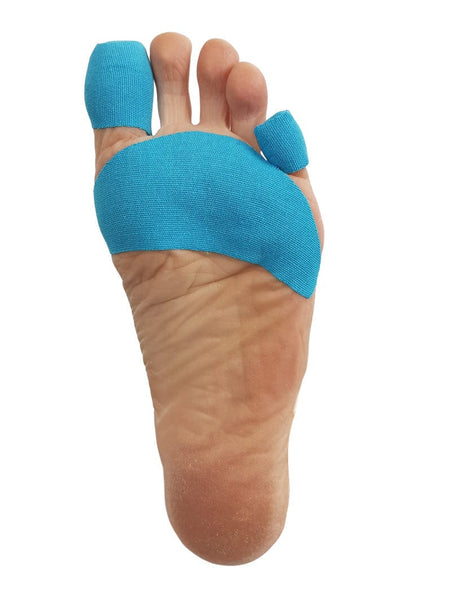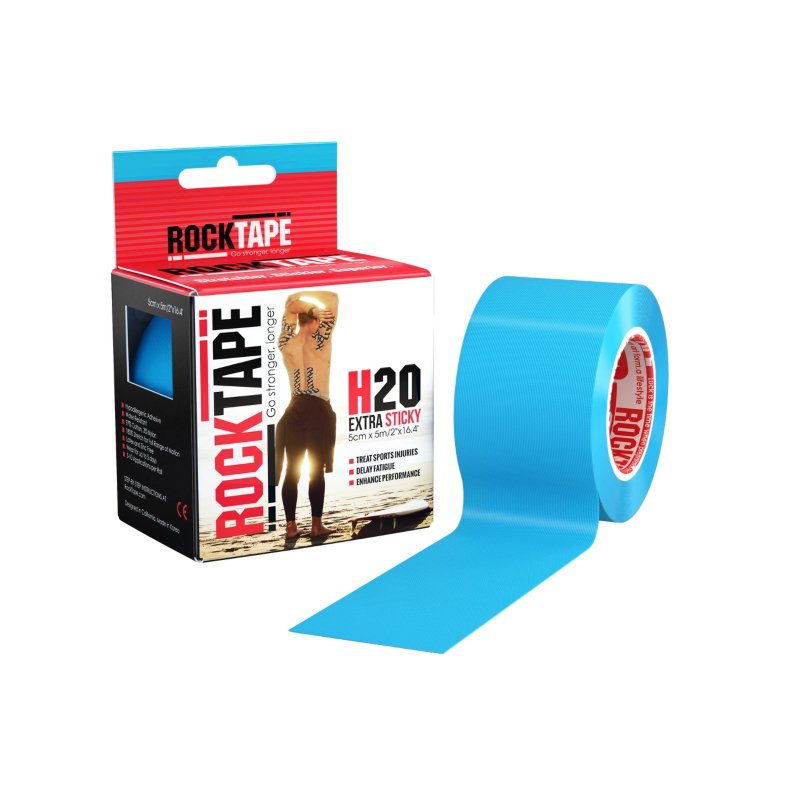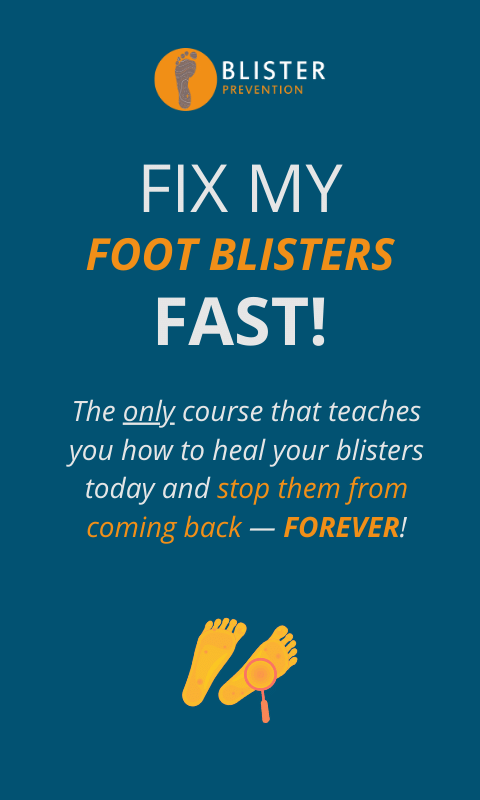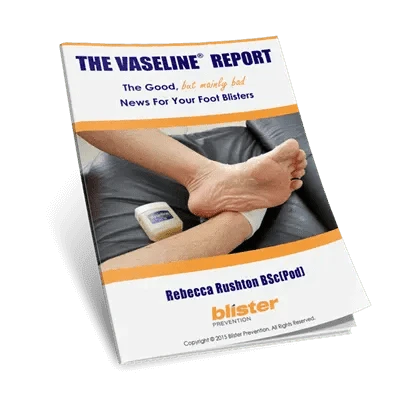When it comes to flexible tapes used on the feet for preventing blisters, there are two standout options. The first is the super-thin Fixomull Stretch. The other is the slightly thicker kinesiology tape, RockTape. But which one? The best RockTape for blister prevention on the feet is RockTape H2O. Not standard RockTape; and not RockTape's Blister Kit either - that's just standard RockTape cut into strips.
In this article, we'll explore the unique properties of RockTape H2O and why it's a better choice for blister prevention for the feet, especially sweaty feet.
The Challenging In-Shoe Environment
Ever put an adhesive bandage on your foot at the start of the day, only to find it has come unstuck within a few hours and rendered useless? I have! It’s little wonder, when you think about the uniquely challenging environment your feet live in.
Wrapped in socks and shoes when we exercise, even the average person’s feet sweat a lot! Sweat production of the foot has been estimated to range between 381 to 447 grams per hour! This extraordinary amount of perspiration has limited means of escape. It's clear to see, this perpetual source of moisture is a constant threat to adhesion. Then, if you add to the average sporting situation:
- Hot, humid conditions
- Extended durations
- Rain, snow or stream crossings
- Or sweatier than average feet
It’s clear to see, standard adhesive products can’t be relied on. That is, if you want to guarantee your tape stays exactly where you applied it, without bunching up at the edges and becoming uncomfortable, or ending up in a ball at the end of your sock.
RockTape H2O Originally Developed for Water Polo
With standard RockTape providing insufficiently durable in the pool, the need for an extra sticky tape became apparent. To cater to water sports athletes, RockTape developed a proprietary Level 3 “Extra Sticky” version. And RockTape H2O was born.
Extra Sticky Level 3 Adhesive
The reason RockTape H2O can survive hours in the pool, is the same reason that makes it perfect for feet. RockTape’s level 3 adhesive provides a more durable taping application, in the presence of moisture.
Perspiration can compromise the adhesive of regular kinesiology tape, but not RockTape H2O. Its waterproof and sweatproof design means it remains securely in place, even in the face of excessive perspiration, and saturating environmental conditions.
Importantly, despite its exceptional stickiness and durability, RockTape H2O is also breathable and flexible. This is a crucial factor in applying it to fiddly areas like your toes. It allows your skin to breathe and move naturally while providing a layer of protection.

Rocktape H2O used as a blister prevention on the big toe, pinky toe, and under the ball of foot.
Gentle On Your Skin
RockTape H2O’s extra sticky kinesiology tape holds firmer, without irritating your skin. It’s:
- Hypoallergenic
- Zinc-free
- Latex-free
- Won’t leave a sticky residue on your skin
RockTape H2O: A Closer Look
Here’s why RockTape H2O makes it an excellent choice for a blister prevention tape, especially for those dealing with sweaty feet.
- Ultra-strong and sticky
- Hypoallergenic adhesive
- Water resistant
- 97% Cotton, 3% Nylon
- 180% Stretch for full range of motion
- Latex-free and zinc-free
- Sticks 2-7 days
- Each roll is 2" x 16.4' (5cm x 32m)
RockTape H2O Is Used By:
- Podiatrists and athletic trainers who treat foot issues
- Profuse sweaters
- Water sports athletes
- Athletes in hot humid climates
- Athletes in wet and snowy climates
- Miners and farmers where the feet are wet for extended periods
- Ultra-endurance athletes
How to Apply RockTape for Blister Prevention
Using RockTape H2O to prevent blisters is a straightforward process, but it's essential to apply it correctly to maximise its benefits. Here's a step-by-step guide on how to use RockTape H2O for blister prevention:
Clean and dry your feet: Before applying RockTape H2O, ensure your feet are clean and dry. Removing any dirt, oils, lubricant’s creams or moisture to help the tape achieve a firm initial bond with your skin.
Measure and cut the tape: Cut the desired length of RockTape H2O, depending on the area you want to protect from blisters. You can cut it into strips or shapes that fit your needs.
Round the edges: To minimise the chance of your tape peeling at the corners, round the edges.
Apply with proper tension: Stretch the tape slightly as you apply it to the area prone to blisters. This helps you minimise wrinkles or folds without restricting movement or circulation. Be sure to avoid too much stretch at either of the ends - stretch it as you go.
Smooth it out: Gently hold or rub the tape to warm and activate the adhesive. This will ensure it is securely in place.
Allow time to set: Give the tape a few minutes to adhere fully before putting on your socks and footwear. Taping expert John Vonhof even recommends applying it the night before your event, to give it extra time and opportunity to adhere. Make sure your socks don’t catch the edges of the tape as you pull them on. With any tape in place on your feet, it’s best to either roll your socks on, or stretch them over the tape.
Technically Speaking
Blisters are caused by soft tissue shear. Watch this video to understand this concept better. Taping helps prevent blisters by spreading shear load over a larger area, thereby reducing peak shear. It can also provide a tiny bit of cushioning. It’s important to understand, there will still be some shear distortion occurring in your skin and soft tissues, even with tape in place, but it will be reduced a little. If you get blisters in spite of taping, search for your blister location (eg: back of heel) to find preventions that provide a higher degree of protection.
To learn more about the research behind blister taping, how taping works and application techniques, click here.
Conclusion
If taping is your go-to blister prevention strategy and you’re looking for a tape that’s just a bit thicker than Fixomull but every bit as stretchy and sticky, then RockTape H2O is the tape you’ve been waiting for. It offers an extra sticky and durable solution to cover your blister-prone areas that you can count on. Even in the toughest conditions, and especially if you’re dealing with sweaty feet.








